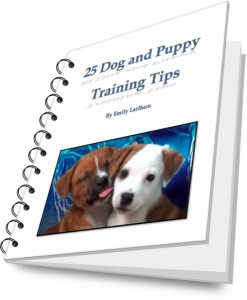By Emily Larlham
While searching the internet one day for “dog training tips” to see what the average person finds when browsing the internet for training help, I came across a tip that many people believe, yet I find detrimental to training. The commonly believed tip is that you should train your dog one behavior at a time, and only train new behaviors after the dog has learned the first behavior completely.
The idea behind the tip is well meaning; to not confuse a dog while training. But training like this could potentially cause you problems. I am not saying you can’t train this way, as I assume many people do, but I would like to state some of the beneficial reasons for training multiple behaviors at the same time and even in the same training sessions.
The problem with training only one behavior at a time until it’s “perfect” is that training sessions can become very predictable and boring. If you do not succeed quickly with that one behavior you are 100% stuck and unable to move forward with your dog’s training. That can be down right daunting. There is also the possibility that your dog could learn the pattern and start to associate training sessions with only offering one behavior, and then get confused about offering older previously learned behaviors when you ask for them because the one behavior you are working on is so highly reinforced (as you spend the most time working on it in training).
Some reasons to train your dog or puppy multiple behaviors at the same time, and even in the same training sessions are:
- It adds variety and unpredictability to training sessions.
- You can move on to another behavior if you are struggling with one, then revisit the behavior you were having trouble with at a later date.
- You can expand your puppy’s communication skills and understanding rapidly by teaching your puppy a large variety of cues in the first few weeks.
- You can work on both complex behaviors that take a long time to train as well as simple behaviors that are acquired in just a few simple lessons.
How to prevent your dog or puppy from getting confused during training if you train multiple behaviors at the same time:
1. Train different behaviors that are similar in different locations until you have added a cue to each of the behaviors. For example, the behavior of lying down is similar to the behavior of bowing, both in the way that you initially train the behavior and movement the dog makes to get into the position. To stop the dog becoming confused between the two, you could train them in separate sessions in different rooms of the house. You can also make sure that your cues do not sound the same. “Down” and “Bow” sound much more alike that “Down” and “Curtsey”.
2. Train behaviors that are very different from each other in the same training sessions. Plan your sessions to leave no room for confusion. For example, you could teach your puppy to offer eye contact, put two feet on a box, learn to sit and down, spin left and right, in one training session without him getting confused. However, if you try to teach your puppy to leave food in your hand, and then teach your puppy to follow food in your hand as a lure, you most likely will find that teaching the two behaviors in the same training session make the puppy reluctant to follow a lure because of the previous leave it exercise.
3. Keep notes of what you have trained and what cues you use so that you stay consistent. Keep the sessions unpredictable. In some sessions you can focus only on one behavior, while in others you can work on many behaviors or just a few.

25 Dog and Puppy Training Tips:
For each month of the year, I will release 2 training tips that will be accessible for free at dogmantics.com. If you simply cannot wait for the information to be published online, you can buy the collection of all 25 training tips in an ebook format here: 25 Dog and Puppy Training Tips
This is a list of all the tips included in the ebook, and that will be eventually available online:
- Teaching a dog previously kept outside to be calm inside the house
- The problem with ignoring unwanted behaviors
- Fading a lure
- Adding a verbal cue or changing a cue
- Dogs and babies
- Socializing tips- Our world can be a scary place!
- What to do if your puppy bites you OUTSIDE of a training session
- Changing your thinking from “I don’t like” to “I need to work on”
- What to use as reinforcement
- Treat deliveries
- Teaching your puppy appropriate greetings on leash
- Teaching “All done” for training sessions and dinnertime manners
- Variety is the spice of life… and training!
- Teaching your puppy to walk off leash
- Don’t let your dog free feed
- Don’t only work on one behavior at a time
- Separation training tips
- Monkey see, monkey do- Take advantage of social facilitation
- Always remember to release your dog!
- The importance of handling
- Chewing
- Teaching “Drop” and “Get it”
- What to do if your puppy sits and refuses to budge on a walk
- Generalizing
- Training your dog to do absolutely… NOTHING!
